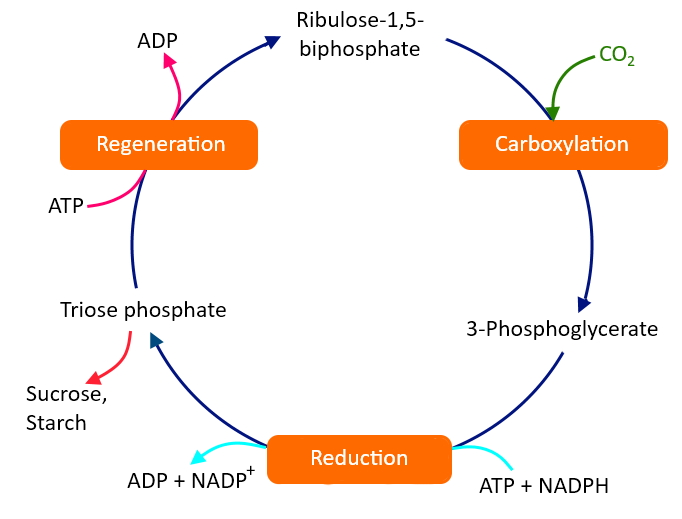
Primary acceptor of $C{ O }_{ 2 }$ in photosynthesis is
(a)Phosphoric acid
(b)Ribulose phosphate
(c)Glucose
(d)Ribulose-1,5- biphosphate
Answer
577.2k+ views
Hint: The primary acceptor of carbon dioxide is an important five-carbon enzyme in the Calvin cycle and helps in carbon fixation. Magnesium ion is essential for its enzymatic activity.
Complete answer:
Ribulose-1,5- biphosphate is one of the enzymes used in the Calvin cycle. Ribulose-1,5- biphosphate helps in fixation of carbon dioxide where:
Carbon dioxide reacts with Ribulose-1,5- biphosphate to form two 3-phosphoglycerate. This reaction is highly exergonic. The reaction is catalyzed by the Ribulose-1,5- biphosphate carboxylase/ oxygenase (rubisco). Rubisco is a soluble enzyme located on the stromal surface of the thylakoid membrane of chloroplasts.
Additional Information:
-In the stroma, in addition to carbon dioxide, two other components are present to initiate the light-independent reactions: an enzyme called ribulose bisphosphate carboxylase (RUBISCO) and three molecules of ribulose bisphosphate (RUBP).
-Calvin cycle occurs in all photosynthetic plants during the dark phase of photosynthesis where it stores the ATP energy during the light reaction in the carbohydrate molecule as the food energy.

So, the correct answer is, ‘Ribulose-1,5- biphosphate.’
Note: -The Calvin cycle was first observed by Melvin Calvin in Chlorella and he was awarded a Nobel prize for this work.
-This cycle involves the main three stages: fixation, reduction, and regeneration.
-Calvin cycle is also known as the dark reaction or ${ C }_{ 3 }$ cycle or reductive pentose phosphate cycle and photosynthetic carbon reduction cycle (PCR).
Complete answer:
Ribulose-1,5- biphosphate is one of the enzymes used in the Calvin cycle. Ribulose-1,5- biphosphate helps in fixation of carbon dioxide where:
Carbon dioxide reacts with Ribulose-1,5- biphosphate to form two 3-phosphoglycerate. This reaction is highly exergonic. The reaction is catalyzed by the Ribulose-1,5- biphosphate carboxylase/ oxygenase (rubisco). Rubisco is a soluble enzyme located on the stromal surface of the thylakoid membrane of chloroplasts.
Additional Information:
-In the stroma, in addition to carbon dioxide, two other components are present to initiate the light-independent reactions: an enzyme called ribulose bisphosphate carboxylase (RUBISCO) and three molecules of ribulose bisphosphate (RUBP).
-Calvin cycle occurs in all photosynthetic plants during the dark phase of photosynthesis where it stores the ATP energy during the light reaction in the carbohydrate molecule as the food energy.

So, the correct answer is, ‘Ribulose-1,5- biphosphate.’
Note: -The Calvin cycle was first observed by Melvin Calvin in Chlorella and he was awarded a Nobel prize for this work.
-This cycle involves the main three stages: fixation, reduction, and regeneration.
-Calvin cycle is also known as the dark reaction or ${ C }_{ 3 }$ cycle or reductive pentose phosphate cycle and photosynthetic carbon reduction cycle (PCR).
Recently Updated Pages
Master Class 12 Business Studies: Engaging Questions & Answers for Success

Master Class 12 Economics: Engaging Questions & Answers for Success

Master Class 12 English: Engaging Questions & Answers for Success

Master Class 12 Maths: Engaging Questions & Answers for Success

Master Class 12 Social Science: Engaging Questions & Answers for Success

Master Class 12 Chemistry: Engaging Questions & Answers for Success

Trending doubts
What is meant by exothermic and endothermic reactions class 11 chemistry CBSE

Which animal has three hearts class 11 biology CBSE

10 examples of friction in our daily life

One Metric ton is equal to kg A 10000 B 1000 C 100 class 11 physics CBSE

1 Quintal is equal to a 110 kg b 10 kg c 100kg d 1000 class 11 physics CBSE

Difference Between Prokaryotic Cells and Eukaryotic Cells




